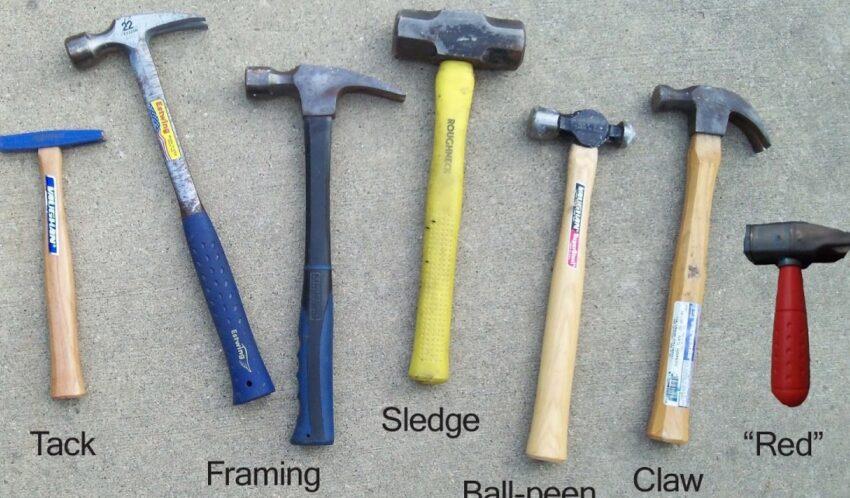A hammer in the household is an irreplaceable thing, especially if you are used to doing a lot with your own hands. With the help of this simple tool, you can perform not only the usual operations for us, for example, hammer in a nail, but also many other works, because today there are many different hammers for different applications. Let’s figure out what types of hammers there are, what is their purpose, and we will try to decide how to choose a hammer.
HAMMER CONSTRUCTION AND BASIC MATERIALS
The first hammer appeared a long time ago. We can say that this is the first of the tools that people used for their needs. We have all seen the hammer, held it in our hands many times, and we know that the simplest hammer consists of two main elements: the handle and the head.
The head has an asymmetrical shape, one part of it has a sharp point, which is called a wedge, and the other part is flat or slightly convex, it is called a firing pin. This is the main striking part of the hammer, which does the bulk of the work. It has sufficient strength and surface area to withstand repeated impacts on hard surfaces. The wedge-shaped part of the hammer is used for splitting something or for minting. Its shape allows for greater impact force due to the smaller contact surface area.
In the center of the head there is a special hole for attaching the handle, which is called a sucker. Usually it is made in the form of a round or oval hole, which smoothly turns into a cone. After attaching the head to the handle, the part of it that protrudes from the hole is wedged so that it completely occupies the inner cavity of the seat. This fastening prevents the head from falling off.
In order to ensure high strength and durability of the head, it is made of high-strength metal by forging, casting or milling, followed by heat treatment. Special hardening modes allow achieving high surface strength with a tough core. The hardened surface layer reaches 3-5 mm. This structure provides high hardness, but at the same time protects the head from brittleness. To protect the head from corrosion, it is covered with a galvanized coating or special types of paints are used.

Wood has always been the universal material for making hammer handles. It is very durable, does not slip in the hand and has a long service life, and if you break the handle during use, it is very easy to replace or even make yourself. It is very important that the grain of the wood from which the handle is made are perpendicular to the head. In this case, if it breaks down, you will not be injured. The wood species must be of a certain type.
For these purposes, beech, birch, ash, oak, hornbeam, maple or mountain ash are well suited. Pine, aspen, alder and spruce are not suitable species.
There are handles made of metal or plastic, and more modern hammers come with fiberglass handles. This is a new material that has proven itself very well in use. It does not slip in the hand and helps to reduce the force of recoil on impact. The metal handles are hollow inside, have the shape of a circle in cross-section, and are covered with rubber for ease of use. The plastic handles are also covered with rubber. Plastic, metal or fiberglass grips have two advantages over wood: they do not dry out over time and they do not swell when in contact with water. Choose depending on what material is more convenient and pleasant for you to work with. The main thing is that the handle is much lighter than the head and has the appropriate length.
MACHINE’S HAMMER AND ITS PURPOSE

The design of the bench hammer is described in detail in the first paragraph. This is the simplest and most common type of working tool. It is designed for hammering, breaking, bending or straightening parts. The pointed edge in the form of a wedge allows you to hammer in a nail with a small head and work in a hard-to-reach place where the wide part of the head cannot fit.
The striker of a locksmith’s hammer can have not only a square, but also a round shape in cross-section. The square type has one drawback – if at the moment of impact you skewed the hammer and the inclined angle fell on the surface of the material being processed, there will certainly be a dent on it. Such defects are especially distressing when assembling new furniture.
Since the bench hammer is designed to deliver multiple series of blows, it must be made of a very durable material. Chrome vanadium steel, which has increased hardness, is perfect, which will help to avoid deformation or destruction of the striker. The weight of a locksmith’s hammer varies from depending on its number. There are five numbers in total, weight No. 1 – 200 g, No. 5 – 800 g. Choose the weight of the hammer, depending on the type of work and physical strength of the worker. The handle length, on average, is 300-400 mm.
CARPENTER’S HAMMER

The construction of the carpentry hammer has a distinctive feature. At one of its ends, a special slot is made, which can have a different angle of separation and slightly curved edges. This bifurcation serves to extract nails from the required surface. Hammers with a large groove angle are called Californian, and with a smaller angle, European. But not all carpentry hammers are designed with a nailer at one end. There are tools with a conventional wedge at the end and a perfectly straight striker.
The handle can be made of wood, metal or plastic with a rubber coating to prevent slipping in the hand. Such hammers are considered more accurate than percussion instruments. The mass of its head is in the range of 100-800 g with a step of 50 g.
A carpentry hammer can look as simple as a tool steel hammer and a wooden handle, or it can have a more ergonomic shape and some additional functions. For example, its handle can be made of high-strength fiberglass or carbon material, and the impact part can be made of titanium or other high-strength steel with a special anti-corrosion coating and has undergone special heat treatment. As an additional function, a nail holder can be present, which allows you to do the work with one hand. And its design can be collapsible or prefabricated, which makes it very compact and easy to store.
SLEDGEHAMMER

This is the largest, most powerful and heaviest type of hammer. The weight of such a tool can reach 4-10 kg, but there are also more serious tools with a weight of the working part and up to 16 kg. They are used for work that requires a large impact force, but low accuracy, for example, dismantling partitions, old tiles, crushing concrete or stone, driving pillars into the ground, driving wedges and other hard work.
The head of this tool is made of high-strength steel by forging with subsequent heat treatment in the form of hardening to the required hardness and can be in the form of a parallelepiped or a conventional hammer. By the way, the depth of the hardened layer after hardening reaches 30 mm. The handle has a larger diameter and length compared to previous models, which means two-handed operation.
The length of the handle is directly proportional to the weight of the working part of the sledgehammer: the higher it is, the longer the handle and can reach 120 cm, but usually it is in the range of 80-90 cm. The cheapest sledgehammers have a wooden handle, but they can also be all-metal.
The hole into which the handle is inserted is tapered, and the handle itself is inserted from above and does not need to be wedged. This assembly method completely prevents the massive head from sliding off. When working with a sledgehammer, you must be extremely careful, because it is considered a traumatic tool. There are several types of sledgehammer, but the most used is a blunt-nosed sledgehammer weighing 2-16 kg, longitudinal sludge with sharp-nosed transverse, which weigh from 3 to 8 kg. The preferred version of the handle is rubberized, it is more expensive than a wooden one, but the tool will be securely held in your hands and dampen vibration during impacts.
KIYANKA
Straightening hammers can also be attributed to this type of hammer. They are designed for leveling iron products that have suffered deformations, drainage systems, roofing works and other works that involve the use of sheet metal.
This tool has one very interesting feature. The striking part of the straightening hammer is made with an internal cavity filled with sand or fine shot. Such a structure made it possible to completely extinguish the inertia of the hammer during the impact. When working, it does not bounce off the surface and practically “sticks” to it. Such hammers are called inertia-free. They are made of rubber or polyurethane, and some models are made of metal with replaceable heads from a softer material.

Mallets are intended for plumbing and joinery work, namely for straightening, leveling or fitting large elements made of soft metals or wood. The striking part of the instrument is made of rubber or hardwood such as birch or elm. Rubber can be either black or white. White mallets are preferable, since black rubber strikes can leave dark stripes on light surfaces.
The material of the handle is wood, plastic or metal, usually the handle has the shape of a circle in cross section. Depending on the purpose, mallets can have a different shape of the striking part. Carpentry tools are cylindrical or barrel-shaped, while locksmith mallets have one side wedge-shaped. The advantage of these types of hammers is that they do not leave dents or marks on the work surface.
When choosing a mallet, you must focus on the type of work performed. If these are more accurate actions, then a tool of small weight from 220 to 450 g is enough for you, if you need a large impact force, then pay attention to a tool weighing from 900 to 1000 g. The price policy of this type of hammer is very different, but you should not choose the most expensive mallet. You will hardly be able to find differences from the average pricing policy tool, which means that you will overpay for the “name”.
KIRKA OR KYLO

This hand tool is used for working with hard materials, namely, with stone or stony ground, for dismantling old masonry and many other heavy work. The design of the pick is very simple. It consists of a striking part and a handle. The striking part can be double-sided or one-sided. The second option will look like a long spike, at the end of which there will be a rounding or a regular hammer. A reversible pick has either two symmetrical long spikes, or a spike and a narrow blade. In any embodiment, the pins will be slightly bent and form an arc. This design is more productive and allows you to reduce the force of recoil during impact.
A quality pickaxe should be made of high quality tool steel. The handle of the pickaxe has a thickening at the end, to which the striking part is attached, which makes it impossible for it to fall off. Fiberglass or bicomponent rubber coated metal or wood is increasingly used as material for the handle. This is due to their ability to damp vibrations upon impact, the material’s insensitivity to moisture and chemicals, and anti-slip properties. The weight of this instrument may vary. For example, a pickaxe for domestic use weighs 500-600 g, and for more serious work – 2.5-3 kg. The dimensions of the picks are also distinguished in the same way. If the length of the spikes lies in the range from 20 to 30 cm, then this option is more suitable for domestic needs, if from 50 to 70 cm, then for professional ones.
BUSHHAMMER
The design of this type of hammer is very successful for performing construction or installation work, namely for installing paving slabs, for removing excess stone and giving it the necessary shape, for removing an old layer of plaster and many other works related to hard materials.
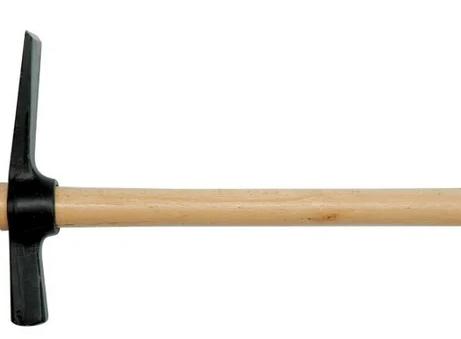
The striking part of the hammer has two different surfaces. One is a square smooth firing pin, and the other has a flat pointed nose. The material for making the head is tool steel, which is very strong, hard and practically not subject to deformation or destruction. The handle of such a hammer can be made of wood, which is the cheapest option, all-metal handles are less common, and more and more often, they began to produce tools with fiberglass handles.
Let’s say you have completed a piece of brickwork, but doubt that its main parameter has been observed – strict perpendicularity to the base. It is for leveling the masonry and bringing it to the ideal that the automatic mason’s hammer serves. It is installed directly on the last row of bricks, its laser levels create a mark to which you need to orient yourself, then each brick is knocked under one level. Very simple, understandable, and most importantly, really functional.
ROOF HAMMER
The name of this tool speaks for itself, this type of hammer was developed specifically for roofing work. The purpose of the hammer is to make holes for fasteners, pry on boards or nails, even chop soft materials or hang up the lathing. And all this thanks to the correct tool design. One of the sides of its striking part is made in the form of a conventional impact striker, but the second, which performs the main functions, looks like a sharpened forked claw, one of the ends of which is shorter than the first by about 2/3.

To choose a reliable roof hammer, you need to pay attention to the material from which it is made. It should only be chrome vanadium steel. Due to the fact that it is alloyed with a component such as vanadium, which is considered one of the most refractory materials, its strength reaches significantly higher values than conventional steels. In addition to the material, special heat treatment must be performed in the form of high-temperature hardening, and to protect against corrosion, the impact part is coated with special varnishes or paints.
The handle can be made of wood or fiberglass, or it can be all-metal. The weight of the roof hammer should be chosen depending on the intensity of the work that you plan to carry out. If it will be heavy installation work that requires serious effort, then you should choose a heavier tool, weighing from 600 to 900 g. If these are more accurate and simple tasks, then give preference to a lighter hammer weighing from 200 to 500 g.
WELDER’S HAMMER
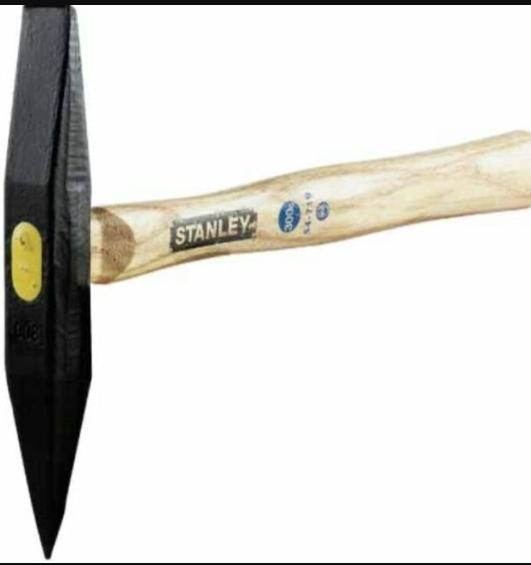
Perhaps not everyone knows about the existence of this type of hammer. It is used when carrying out welding works of varying complexity. It serves to remove slag from the surface of the weld. So that after welding, the worker can check the integrity of the seam and the correctness of its execution, performing light blows with a welding hammer, he cleans the surface, thereby providing himself with good visibility.
With this tool, you can remove the scale and spatter of hot metal that are formed during electrode welding. The construction of a welding hammer is a bit like a pickaxe. It is also made in the form of a chisel at one end and a thin tip at the other, only it does not have arcuate bends. It is with the help of the tip that slag residues in the weld are removed. The weight of this tool is very small, no more than 300-350 grams, but more is not required, because it is more accurate than power work. The most common material for the handle is wood, less often it is made of all-metal, and the impact part is made of durable tool steel with subsequent heat treatment in the form of hardening.
PLASTERBOARD HAMMER
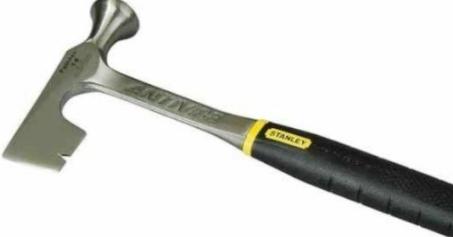
How often have you had to work with drywall? At least once in a lifetime, probably for sure. After all, this is almost a universal material from which you can make many design elements with your own hands. To make your work easier, they came up with a special hammer for working with this material. Its design has one end, made in the form of a hatchet, and the other – rounded. With it, you can chip off excess drywall pieces.
For example, you are faced with the task of making an arch. You have already completed the main part of the task – you have made the frame, it remains only to sheathe it. All the necessary elements have already been cut out, you already hold a screwdriver in your hand, apply a fragment with your other hand and start editing, and at the last moment you notice that there is clearly an extra piece that goes beyond the necessary limits. Don’t unscrew the whole piece back to cut it, right? This is where a drywall hammer comes in handy. And if you need to hammer something into drywall, then the rounded striking part of this tool will not leave dents on the soft surface.
COPPER HAMMER

The advantage of this type of hammer is that it does not produce sparks when struck. This feature allows you to work in hazardous areas. The striking part usually has a rectangular shape and, accordingly, is made of copper – a non-ferrous metal of red color. Copper is known for its increased resistance to corrosion, it does not change its strength characteristics even at very low temperatures, it is not affected by chemicals, so a copper hammer will serve you for many years. The handle of this tool is usually made of wood. Its weight ranges from 200 g to 2 kg.
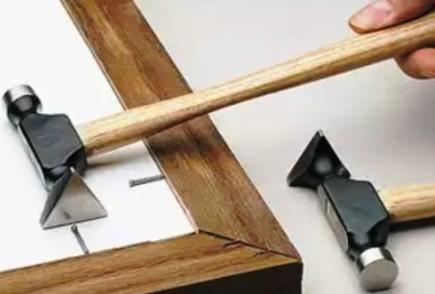
This hammer is rarely used, which we consider an undeserved omission. It performs one single, but very convenient function. It can be used to hammer in window glazing beads. Indeed, in cross-section, its striking part has the shape of a trapezoid, which tapers towards the end. This way, you will accurately hit the carnation and not the glass or frame. After all, this is probably what happened when you tried to do it with an ordinary locksmith’s hammer. The weight of this hammer is no more than 125 g. It is thanks to the small dimensions and the special shape of the striker that it is very convenient. The handle is made of wood, and the striking part of their tool steel.
WHAT TO PAY ATTENTION TO WHEN CHOOSING A HAMMER
In view of the considerable number of types of hammers that we have considered in detail, you should be very careful when buying. Whatever hammer you need, always pay attention to the quality of its execution. Examine it carefully.
Wooden handles should not have knots or individual long fibers. They should be perfectly smooth and even without cracks. Plastic, fiberglass or fiberglass handles should also not be cracked. Rubberized handles should have an even coating without blistering or flaking. The color should also be uniform. If there is a light spot somewhere, this indicates a thin coating layer.
Do not buy hammers with all-metal handles that are not specially nubbed or coated. Such a tool will constantly slide out and transmit strong vibrations upon impact. The place of attachment of the handle to the striking part should not have gaps and backlash. It should sit firmly in place and even after the application of force should not move. Now it’s time to test the strength of the material from which the impact part is made. Since you are in the store, the only thing you can do is take a second hammer and hit it on the surface of the firing pin of the hammer you like. The seller will most likely be unhappy, but you will immediately understand whether to make a purchase. There should be no dents or scratches on the surface.
Also pay attention to weight. If you are buying a hammer for home use, a 350-450 gram tool will suffice. For heavier work, a weight of at least 600 g is required. If the impact test and visual inspection are successful, then feel free to purchase your new assistant.
